
Adding Ublituximab to Ibrutinib Improves Relapsed CLL Response Rates
Adding the novel CD20 inhibitor ublituximab to ibrutinib offered improved response rates and greater depth of response over ibrutinib alone in patients with relapsed/refractory chronic lymphocytic leukemia.
Adding the novel CD20 inhibitor ublituximab to ibrutinib offered improved response rates and greater depth of response over ibrutinib alone in patients with relapsed/refractory chronic lymphocytic leukemia (CLL), according to results of the phase III GENUINE trial (
“Ibrutinib has transformed the management for patients with relapsed CLL,” said Jeff P. Sharman, MD, of the Willamette Valley Cancer Institute and Research Center in Eugene, Oregon. “Unfortunately for patients with high-risk molecular features, such as 11q deletion, 17p deletion, or TP53 mutation, relapses remain problematic, and improving clinical outcomes in this patient population remains an unmet medical need.”
In earlier studies, ublituximab showed single-agent activity in rituximab-refractory CLL patients, and a phase II trial in combination with ibrutinib showed an overall response rate of approximately 88%.
Sharman presented results of the GENUINE trial at the 2017 American Society of Clinical Oncology (ASCO) Annual Meeting in Chicago. The open-label trial randomized 126 patients to either ublituximab plus ibrutinib (64 patients) or ibrutinib alone (62 patients); 9 patients never received treatment. The trial initially planned overall response rate (ORR) and progression-free survival (PFS) as co-primary endpoints, but due to enrollment problems the investigators reduced the target number of patients and changed PFS to a secondary endpoint.
All patients had relapsed/refractory CLL, with confirmed presence of 17p deletion, 11q deletion, and/or TP53 mutation. Patients had a mean age of 67 years, and a mean time from diagnosis to randomization of approximately 6.5 years.
The combination therapy patients had an ORR of 78%, compared with 45% with ibrutinib alone (P < .001). Furthermore, 19% of ublituximab patients were minimal residual disease (MRD)-negative, compared with 2% of ibrutinib monotherapy patients. In the combination group, 66% of patients had a more than 75% change in nodal size, compared with 52% of monotherapy patients.
The hazard ratio for progression with ublituximab was 0.559 (95% CI, 0.216–1.443; P = .229), but again, the study’s slow enrollment meant it was not adequately powered to assess PFS.
The safety profile was generally similar to that seen with ibrutinib alone, with the exception of infusion reactions. More than half of the ublituximab patients (54%) experienced an infusion reaction of any grade, and 5% had a grade 3/4 infusion reaction; oral ibrutinib obviously resulted in no such reactions.
“The GENUINE study met its primary endpoint, demonstrating that ublituximab in combination with ibrutinib yields superior ORR to ibrutinib alone, with greater number of responses and greater depth of response,” Sharman concluded.
Nitin Jain, MD, of MD Anderson Cancer Center in Houston, was the discussant for the session, and he agreed that the addition of ublituximab may offer a promising option in relapsed/refractory patients. “Certainly a longer follow-up of this study would be required to see what happens to these patients over time,” he said.
Newsletter
Stay up to date on recent advances in the multidisciplinary approach to cancer.

















































































